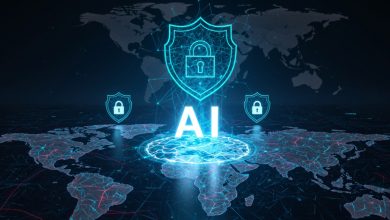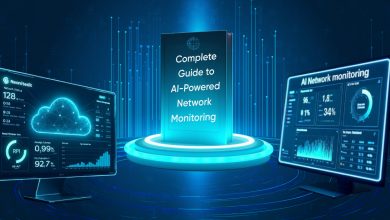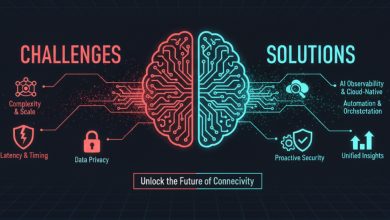Multi-Cloud Network Monitoring Best Practices
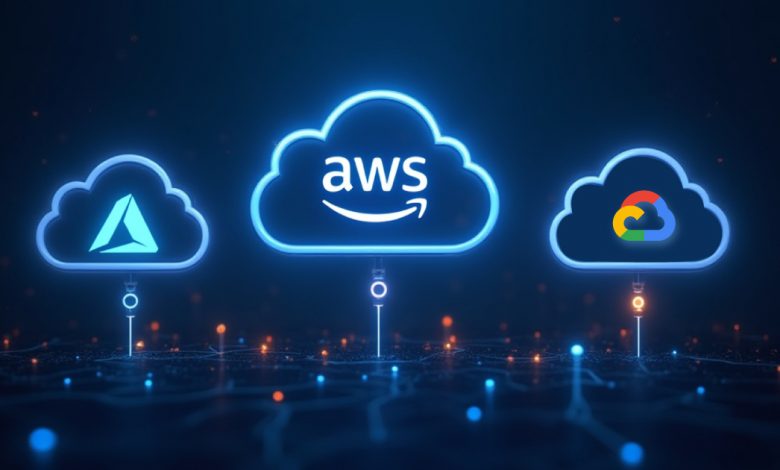
Introduction
By 2025, enterprises are no longer asking whether to use cloud computing but how extensively to adopt multi-cloud. Leveraging providers like AWS, Azure, and Google Cloud has become standard, offering flexibility, resilience, and competitiveness. Yet, managing networks across multiple clouds brings complexity; poor monitoring can cause performance, visibility, and security risks.
This article explores key challenges in multi-cloud monitoring, along with best practices, tools, and future trends to ensure visibility, resilience, and efficiency.
Why Multi-Cloud Network Monitoring Matters in 2025
- Business Continuity: Downtime in one cloud shouldn’t bring down the entire business. Monitoring ensures seamless failover and continuity.
- Customer Experience: Latency and bottlenecks can affect digital experiences. Monitoring helps identify issues before users notice.
- Security: Multi-cloud networks expand the attack surface. Monitoring provides early warning against threats.
- Cost Control: Data transfer fees and resource overprovisioning can blow up costs. Monitoring helps optimize usage.
In short, without effective monitoring, the benefits of multi-cloud can quickly turn into risks.
Challenges of Multi-Cloud Network Monitoring
Managing Multi-Cloud Environments is Complex
Every cloud provider has unique architectures, APIs and monitoring tools. AWS CloudWatch, Azure Monitor and GCP Operations Suite collect data differently. Managing these in silos makes it hard to get a unified view.
Common Pitfalls: Blind Spots, Latency and Tool Overload
- Blind Spots: Traffic between clouds goes unmonitored.
- Latency Issues: Inter-cloud communication introduces delays.
- Tool Overload: Too many dashboards and alerts cause “alert fatigue”, and you miss critical signals.
Six Best Practices for Multi-Cloud Network Monitoring
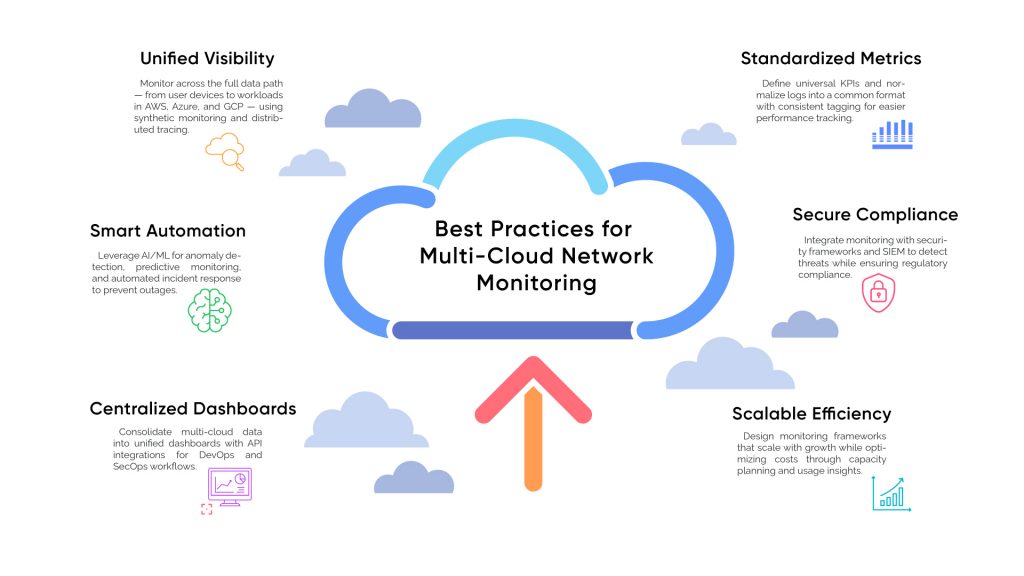
1. Have End-to-End Visibility Across All Cloud Providers
- Monitor not just within individual clouds but across the entire data path, from user devices to workloads spanning AWS, Azure, GCP and beyond.
- .Use synthetic monitoring and distributed tracing to capture cross-cloud dependencies.
2. Standardize Metrics and KPIs for Consistent Performance Tracking
- Define universal KPIs: latency, packet loss, throughput, uptime and jitter.
- Normalize logs and metrics into a common format for easier comparison.
- Use consistent tagging across resources to simplify filtering.
3. Leverage Automation and AI/ML for Smarter Monitoring
- Automate anomaly detection to catch subtle issues faster.
- Apply machine learning to identify performance trends and predict outages.
- Automate incident responses such as rerouting traffic during outages.
4. Integrate Security and Compliance into Monitoring Workflows
- Track suspicious traffic, failed authentication attempts or unexpected data transfers.
- Align monitoring with compliance frameworks like HIPAA, GDPR or PCI DSS.
- Use integrated SIEM (Security Information and Event Management) for end-to-end visibility.
5. Centralize Dashboards and API Integrations
- Consolidate data from AWS, Azure, GCP and private clouds into a single dashboard.
- Use APIs to integrate monitoring data with DevOps and SecOps workflows.
- Ensure dashboards support role-based access for different teams.
6. Plan Monitoring for Scalability and Cost Efficiency
- Design monitoring frameworks that scale as your cloud footprint grows.
- Track egress costs to minimize expensive cross-cloud transfers.
- Use historical monitoring data for smarter capacity planning.
Get our expert checklist and tool comparison to start reducing downtime today.
Tools and Strategies for Multi-Cloud Network Monitoring
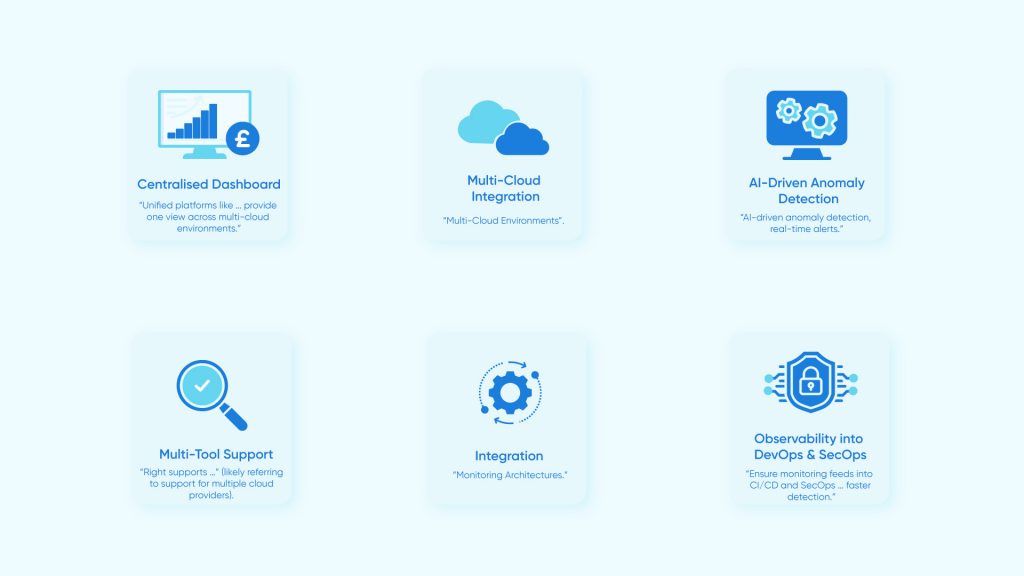
Centralized Dashboards for Cross-Cloud Visibility
Platforms such as Datadog, Dynatrace, ThousandEyes, and Splunk unify monitoring across multi-cloud environments, offering a single pane of glass for visibility.
Choosing the Right Multi-Cloud Monitoring Tools
Look for tools that:
- Support multiple cloud providers.
- Offer AI-driven anomaly detection.
- Provide real-time dashboards and alerting.
Integrating Observability into DevOps and SecOps
- Incorporate monitoring into CI/CD pipelines to detect issues early.
- Ensure network monitoring data feeds into SecOps workflows for better threat detection.
Optimization Techniques for Multi-Cloud Network Performance
Reducing Latency and Improving Cross-Cloud Connectivity
- Use direct interconnects between providers (like AWS Direct Connect, Azure ExpressRoute or Google Cloud Interconnect).
- Deploy workloads closer to end users via regional availability zones.
Optimizing Costs Through Smarter Monitoring Practices Monitor traffic flows to reduce unnecessary inter-cloud transfers.
- Set alerts for unusual egress spikes.
- Right-size resources based on actual usage trends.
Multi-Cloud Capacity Planning and Resource Allocation
- Use predictive analytics to forecast demand.
- Allocate bandwidth and resources proactively to prevent congestion.
- Run regular stress tests before peak traffic seasons.
Future Trends in Multi-Cloud Network Monitoring
The Role of AIOps in Multi-Cloud Monitoring
AIOps platforms will increasingly use machine learning to automate detection, correlation, and remediation, reducing human effort.
Zero Trust and Secure Monitoring in Distributed Networks
Zero trust principles “never trust, always verify” will extend to monitoring, ensuring continuous validation of all cross-cloud traffic.
The Rise of Edge and Multi-Cloud Monitoring
With edge computing gaining traction, monitoring will expand beyond centralized clouds to include distributed edge nodes, requiring even deeper observability.
Conclusion
Multi-cloud success needs more than deployment; it demands visibility, standardized metrics, and AI-driven monitoring for reliability and cost control. With centralized dashboards, security integration, and AIOps, enterprises can cut downtime and turn complexity into a competitive edge.
Explore our guides on cloud cost optimization and AI-enhanced network monitoring to future-proof your infrastructure.
Frequently Asked Questions
Monitoring performance, security, and availability across multiple cloud providers (AWS, Azure, GCP, etc.).
Multi-cloud introduces complexity with different providers, diverse traffic flows, and bigger attack surfaces — visibility is key.
Blind spots, latency issues, tool sprawl, compliance requirements, and correlating metrics across providers.
Datadog, Dynatrace, ThousandEyes, Splunk, and New Relic — all offer centralized dashboards and AI-driven insights.
Track cross-cloud data transfers, right-size resources, and use monitoring to uncover inefficiencies that increase egress fees.
AI/ML automates anomaly detection, predicts outages, correlates complex events, and enables faster incident response.

Tony Davis
Director of Agentic Solutions & Compliance

